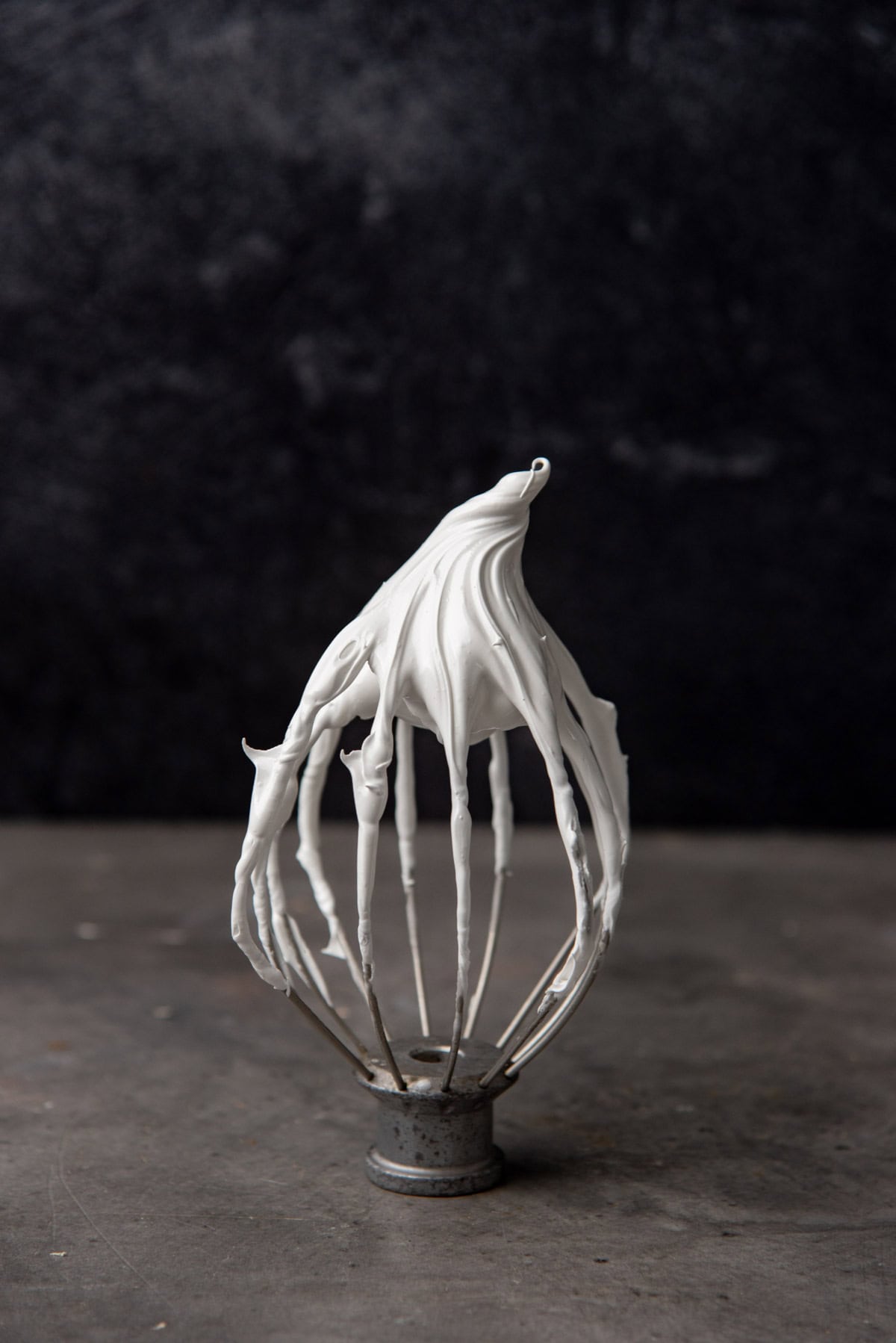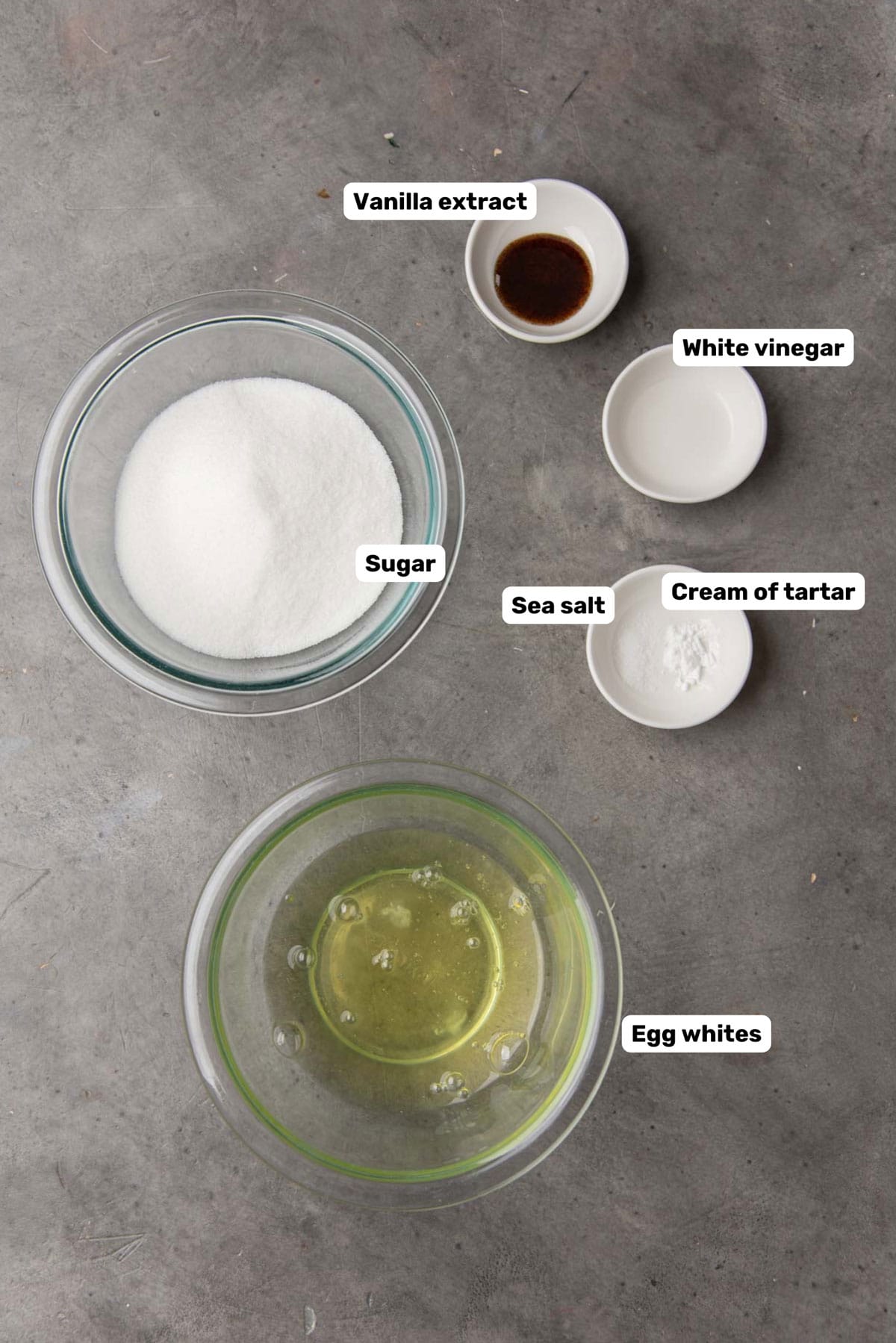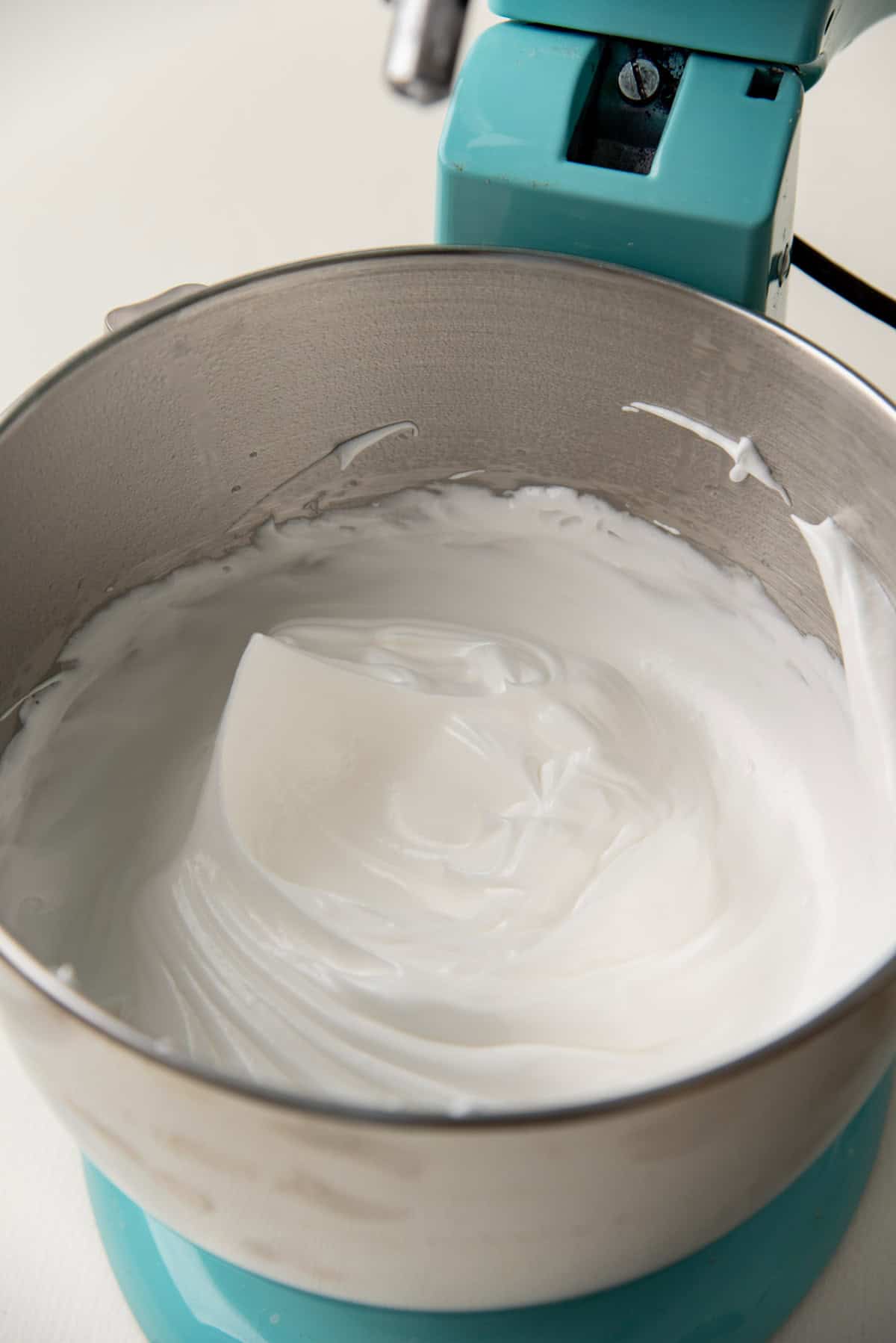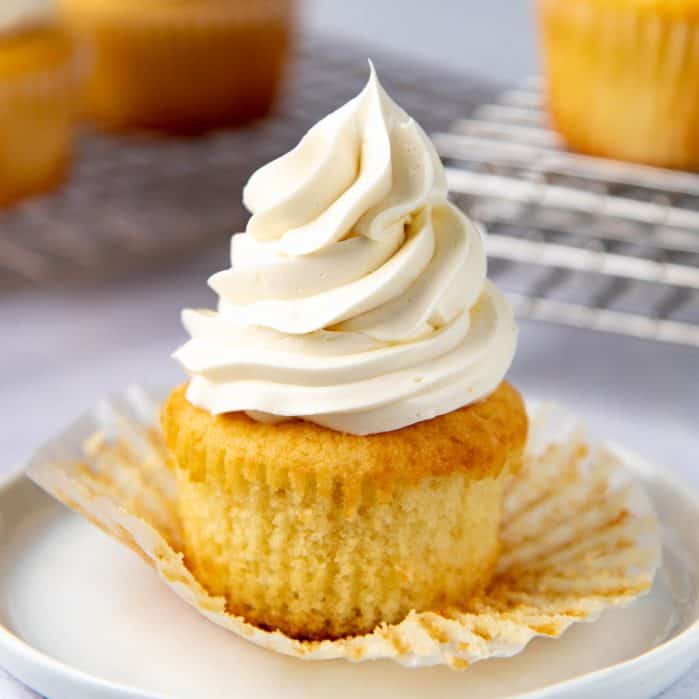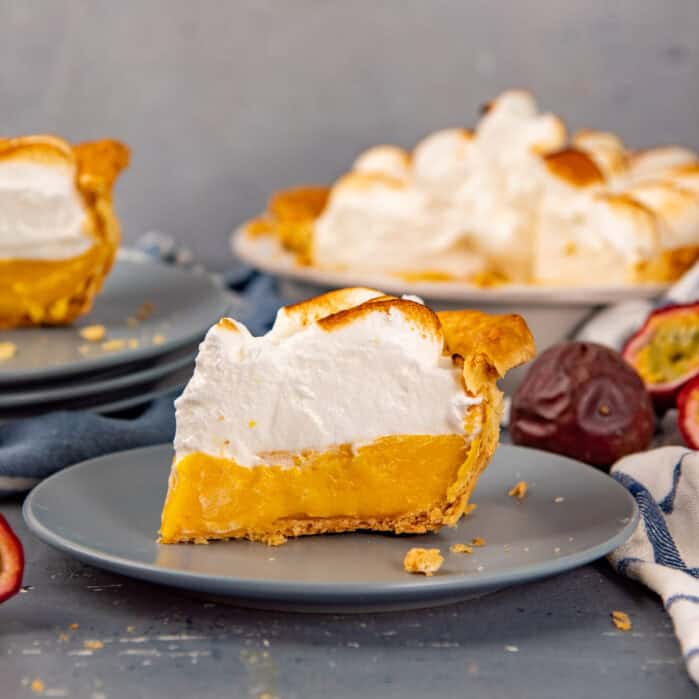Use it to make classic lemon meringue pie, lemon meringue cocktail, passion fruit pie or any other application and learn to make different variations too with this foolproof recipe.
Swiss meringue vs Italian meringue vs French meringue
Three different methods of making meringue.
French meringue – Adding fine white sugar to egg whites, while whisking the egg whites. This is the most common way of making meringue. Italian meringue – A hot sugar syrup with a high sugar concentration is added to the egg whites while whisking the egg whites. Swiss meringue – The egg whites and sugar are heated together to dissolve the sugar. Then the egg white and sugar mixture is whisked.
Italian meringue is the most stable of all meringues. It’s great to be used to top dessert pie recipes (and other sweets) because it does not break down and weep easily. It’s not great for baking, as the additional water content makes it harder for it to dry out. But it makes great buttercream. Swiss meringue is more stable than French meringue, but not as stable as Italian meringue. But, it’s also commonly used to top lemon meringue pie and passion fruit pie, and used in other applications as well! Just like Italian meringue, swiss meringue is also great for making buttercream. French meringue is not heated at all, and must be baked before consuming. Many recipes for swiss meringue call for the egg white mixture to be heated only until the sugar dissolves. The temperature of the egg whites for the sugar to dissolve will be around 100 – 140°F. But, I prefer to heat the mixture till it’s 170°F +, so that the sugar is dissolved, the meringue is pasteurized, and the meringue is slightly more stable than if it was only heated to 140°F.
Vanilla bean Lemon extract
Ingredient notes
The egg whites need to be ABSOLUTELY free of any kind of fat. This includes egg yolk or any residual fat that might be on any surface that the egg white comes into contact with. Fresher eggs are easier to separate, and also create a more stable meringue. So, it’ll be easier to work with fresh eggs. I often use the egg float test (egg freshness test) to determine the suitability of my eggs to make meringue with. Sugar is an important ingredient in meringue. The ratio of sugar to egg whites is crucial for stability. For the highest stability, add twice as much sugar as egg whites (by weight). But there is some wriggle room here.
1 egg white = about 30 g. For every 1 egg white (30 g), use between 45 – 60 g of sugar for making most meringues. For this swiss meringue recipe, I use 50 g per 1 egg white. But, if I were making pavlova, I would use 60 g to give it more stability. Did you follow the recipe as best as you could, but just ended up with liquid egg whites that will not stiffen? Then these tips are for YOU! While I have shared a few tips here, I also include pro tips for each recipe step in the highlighted sections in the “How to make Swiss meringue” section below. Fresh eggs have a smaller air pocket within the shell. Therefore it sinks and lays flat on the bottom. As the egg loses its freshness, more CO2 / air enters the egg through the shell. This causes the air bubble to get bigger and makes the egg more buoyant. If the egg is still good to eat, but not as fresh (1 – 2 weeks), the egg will sink, but one end of the egg will point up, staying vertical without laying flat on its side. However, if the egg is not fresh at all, or has gone bad, then the egg will float because the air pocket has become large. Check out my detailed egg float test article where I describe how to tell if eggs are fresh and what applications to use different eggs for.
Step 2 – Separate the egg whites from the yolks
Carefully separate the egg whites in the egg. You can use the shell to do this, or your hands. But make sure your hands are very clean. Take extra care by wiping the bowls, whisk attachment, and utensils with white vinegar. The acidity of vinegar helps to keep the bowls clean and remove any oil residue. Additionally, acidity doesn’t interfere (and can help) with making meringue. Just make sure it’s white vinegar and not a flavored vinegar. Alternatively, you can use an egg separator for convenience. Be very careful not to break the egg yolk, because even a trace of egg yolk in the egg white will prevent the egg whites from forming a meringue. All the egg whites can be placed in the mixing bowl (image 2). Each egg white should be around 30 g. Separate each egg white into a smaller bowl before transferring each into the big bowl. That way, if you accidentally break the yolk in 1 egg, the rest of of the egg whites will not be contaminated!
Step 3 – Add other ingredients
Add the sugar and cream of tartar to the egg whites and whisk gently to break up the egg whites and mix a little with the sugar (image 3). Sugar will help increase the viscosity of the egg white that will also keep the meringue foam stable. For every egg white, add about 50 g of sugar. The mixture will be heated to between 170 – 175 F. I use a digital thermometer to check the temperature. The egg whites will go from an off white frothy consistency to a bright white, thick mixture that resembles royal icing (images 6 – 7). Place the mixing bowl in your stand mixer with the whisk attachment (image 8). Whisk the meringue until it reaches stiff peaks (image 12). The meringue will go through a few different stages. To test these stages, it’s important to just have enough meringue on the whisk to create a small peak. Firm peaks (or mid peaks or medium peaks) (image 11) – This stage is between soft and stiff peaks. The meringue will form a peak at the tip, but it still droops a little, at about a 90 degree angle. Stiff peaks (image 12) – This is what we want to achieve. The peak on the meringue stays up and doesn’t droop. The meringue is thick and glossy. When the meringue is at firm peaks, add the vanilla extract or vanilla beans.
Step 6 – The meringue is ready to be used
Swiss meringue will be stable for a little while, but I recommend using it as soon as you can. Swiss meringue will pipe beautifully as well, so it can be transferred to a piping bag too. Use it as a topping for your pies, like this lemon meringue pie or lemon meringue pie cocktail. This meringue is also great as a cake frosting. Baked alaska or bombe alaska also uses swiss meringue. Swiss meringue can be torched with a kitchen torch or under the broiler in the oven to get a nice caramelized surface.
Variations
Instead of vanilla extract you can also use other extracts as well. Make sure they are alcohol-based extracts and not emulsions or fat-based extracts.
Lemon or any citrus extract Almond extract You can also sieve and fold in freeze dried fruit powders for a fruity swiss meringue! Like raspberry swiss meringue, passion fruit swiss meringue etc. To make chocolate swiss meringue, sift and fold in cocoa powder. However, make sure to use 0% fat cocoa powder, as cocoa powder with higher fat content can destabilize the meringue and make it very hard to pipe.
This is how I like to store leftover egg yolks
Fill a 16 oz deli cup (or any airtight container) with cold water. There should be enough to submerge the yolks and to have at least 1/2 inch of water above the yolks. Carefully place the (unbroken) yolks in the water. Then close the container and keep it in the fridge for up to 2 days.
What you can do with leftover egg yolks
You can make many delicious recipes with the egg yolks!
Lemon curd Lemon meringue pie (use the yolks for the lemon filling, and the egg whites for the topping) Passion fruit meringue pie (use the yolks for the passion fruit filling, and the egg whites for the topping) Homemade banana pudding (my favorite use of egg yolks!) Caramel banana cream pie Pastry cream Creme chiboust (the yolks are used to make the custard base, and the egg whites are folded into the custard) Cured egg yolks Pasta carbonara

